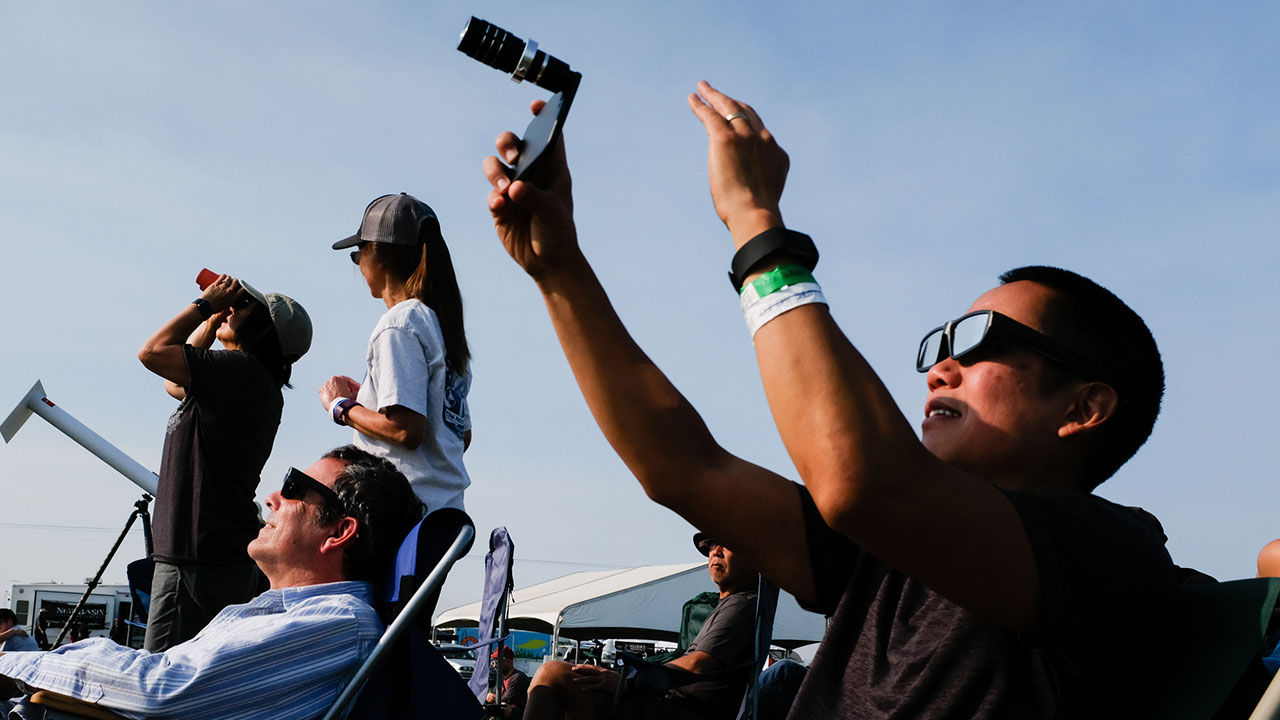How to safely record today's total solar eclipse with your phone
Here's how to safely, and effectively, take stunning photographs and videos of the solar eclipse with your smartphone on April 8.

When today's solar eclipse passes over North America, your first reaction may be to whip out your phone to capture the spectacular sight. But is it safe to record the solar eclipse with your phone? And if so, what's the best and safest way to do it?
Some organizations discourage people from using their smartphones during the eclipse. "Watching a solar eclipse on your smartphone camera can put you at risk of accidentally looking at the sun when trying to line up your camera," Prevent Blindness, a volunteer eye health and safety organization dedicated to fighting blindness and saving sight, says on its website. "It could possibly also damage your smartphone camera. Don't take the risk."
This advice applies only to the eclipse's partial phases, which North Americans outside the 115-mile-long (185 kilometers) path of totality will see today. Besides, if you point your smartphone at a partial solar eclipse, you won't get a good image. That's because whatever remains of the uneclipsed sun, even if it's just a sliver, will overwhelm your smartphone camera's sensor and overexpose your photo.
The only way to take an image of the partial solar eclipse is to use the same filters found in solar eclipse glasses. You can cut your glasses in half and tape one eyepiece over your smartphone camera lens, according to Dr. Ralph Chou, a professor emeritus of optometry and vision science at the University of Waterloo, who has spent a lifetime eclipse chasing, the American Academy of Ophthalmology notes.
Related: 7 safe ways to view the partial phases of the total solar eclipse
You can also buy ready-made smartphone solar filters, like the VisiSolar Smartphone Photo Filter and the Solar Snap Eclipse App Kit. The latter comes with an excellent app that makes it easy to photograph the partially eclipsed sun — with impressive results. A clip-on zoom lens for smartphones designed to provide optical magnification will also work well. These come in a variety of shapes and sizes, and are readily available online.
If you're within the path of totality, you will also see the partial phases of the eclipse. But midway through the 2.5-hour-long event, the sun's entire face will be blocked by the moon. For this brief period, called totality, you can remove the solar eclipse glasses from your eyes and the solar filters from your smartphone. This is the only time it is safe to look directly at the sun without proper eye protection.
Get the world’s most fascinating discoveries delivered straight to your inbox.
The best way to take a photo is to switch off your flash, go ultrawide, lock the focus on the middle distance and compose images with the totally eclipsed sun in the composition, according to Live Science's sister site Space.com. To take a video, put your phone on a tripod a few minutes before totality, engage ultrawide mode, compose the frame and let it record. The bonus of this method is that you'll get images of yourself experiencing totality and an audio recording of how you reacted.
Reminder: It is only safe to view the eclipse without solar eclipse glasses during the few minutes of totality. Even when setting up shots with your phone, Chou advises keeping your solar eclipse glasses on throughout the eclipse, unless you're in the path of totality.
When does totality begin?
The first place on land to experience the total eclipse will be at Mazatlán, Mexico, at 9:51 a.m. local time (12:51 p.m. EDT), while it will be at its longest at Torreón, Mexico, with a maximum duration of 4 minutes, 27 seconds. It will then pass over the continent for the next few hours, before reaching the sea near the Canadian province of Newfoundland and Labrador at 5:16 p.m. local time (3:46 p.m. EDT).
The times of totality in the 13 U.S states that will be able to see the full eclipse are below, so get your cameras ready before these times.
| City | Totality begins | Totality ends |
|---|---|---|
| Dallas, Texas | 1:40 p.m. CDT | 1:44 p.m. CDT |
| Idabel, Oklahoma | 1:45 p.m. CDT | 1:49 p.m. CDT |
| Little Rock, Arkansas | 1:51 p.m. CDT | 1:54 p.m. CDT |
| Poplar Bluff, Missouri | 1:56 p.m. CDT | 2:00 p.m. CDT |
| Paducah, Kentucky | 2:00 p.m. CDT | 2:02 p.m. CDT |
| Carbondale, Illinois | 1:59 p.m. CDT | 2:03 p.m. CDT |
| Evansville, Indiana | 2:02 p.m. CDT | 2:05 p.m. CDT |
| Cleveland, Ohio | 3:13 p.m. EDT | 3:17 p.m. EDT |
| Erie, Pennsylvania | 3:16 p.m EDT | 3:20 p.m EDT |
| Buffalo, New York | 3:18 p.m. EDT | 3:22 p.m EDT |
| Burlington, Vermont | 3:26 p.m EDT | 3:29 p.m EDT |
| Lancaster, New Hampshire | 3:27 p.m EDT | 3:30 p.m. EDT |
| Caribou, Maine | 3:32 p.m. EDT | 3:34 p.m. EDT |

Jamie Carter is a freelance journalist and regular Live Science contributor based in Cardiff, U.K. He is the author of A Stargazing Program For Beginners and lectures on astronomy and the natural world. Jamie regularly writes for Space.com, TechRadar.com, Forbes Science, BBC Wildlife magazine and Scientific American, and many others. He edits WhenIsTheNextEclipse.com.



